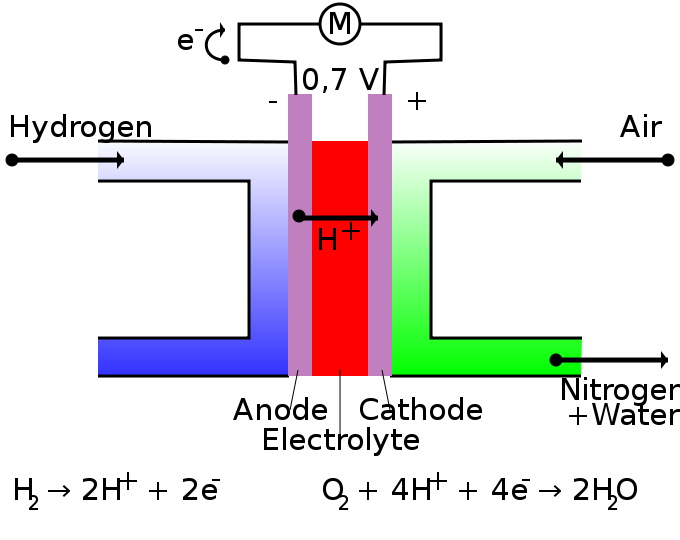A fuel cell is an electrochemical device that converts the chemical energy from the methane in natural gas into electricity through a chemical reaction with oxygen Fuel cells have no moving partsthey are quiet and reliable with durability of up to 20 years. Since SOFCs produce electricity through an electrochemical reaction and not through a combustion process they are much more efficient and environmentally benign than conventional electric power generation.

Book Review Fuel Cells Power Electronics
Each individual cell.

Chemical formula fuel cell. The fuel cell is the same as when you simply burn hydrogen. The answer is efficiency. Fuel cells are similar to batteries but require a continuous source of fuel often hydrogen.
The fuel cell will be used to power the vehicles electronic components while a hydrogen-powered internal combustion engine provides the acceleration power. H 2 1 2 O 2H 2O g rH0 The reaction enthalpy rHis equal to the enthalpy of water forma-tion fH. A fuel cell is a device that converts chemical energy into electrical energy.
If we burn hydrogen in an internal combustion engine like the ones in normal cars the reaction is rapid and uncontrolled and only turns about 20 of the energy in a. Simplifying Hydrogen Generation Mechanical engineering professor Yitung Chen and two graduate students are working with the Southern Nevada division of the England-based Hydrogen Solar. 29102018 The researchers figured out how to convert methane to hydrogen in the fuel cell itself via the new catalyst which is made with cerium nickel and ruthenium and has the chemical formula Ce09Ni005Ru005O2 abbreviated CNR.
Chemists sometime describe diesel as having an average chemical composition of C 12 H 23. But a cell consists of 100 trillions atoms each varying from other ie not a specific type. Fuel cells cleanly and efficiently convert chemical energy from hydrogen-rich fuels into electrical power and high-quality heat via an electrochemical process that is efficient and emits water rather than pollutants as there is no burning of the fuel.
The chemical energy content of any fuel is called heating. 2 h2 o2 2 h2o Why bother with a fuel cell then. In a hydrogen-oxygen fuel cell hydrogen and oxygen are used to produce a voltage.
11 Thermodynamic of H 2O 2 electrochemical device In an H 2O 2 electrochemical device hydrogen is oxidized by oxygen to water in an exothermic reaction. Solid oxide fuel cells SOFC are electrochemical devices that convert chemical energy of a fuel and oxidant directly into electrical energy. Hydrogen oxygen water.
The protons pass through the proton exchange membrane unimpeded and proceed to the cathode side while the electrons are blocked and forced to travel through an external circuit. CO H 2 O CO 2 H 2. Similar to a battery a fuel cell is comprised of many individual cells that are grouped together to form a fuel cell stack.
The overall reaction in a hydrogen-oxygen fuel cell is. Why not just burn the hydrogen. For designing a fuel cell system FCS.
Diesel primarily consists of stable molecules such as C 12 H 22 C 13 H 24 and C 12 H 24. Instead diesel is made of a mix of saturated hydrocarbons and aromatic hydrocarbons. In this cell in contrast carbon monoxide in the hydrogen fuel can react at the anode to generate more hydrogen via a shift reaction.
Hydrogen fuel cells have been used to supply power for satellites space capsules automobiles boats and submarines. And then many such atoms joins to make a drop of water. In principle carbon monoxide can also react with carbonate ions at the anode and can therefore form an alternative fuel for the cell.
When hydrogen comes in contact with the catalyst the hydrogen splits into protons and electrons. They will continue to produce electricity as long as fuel is available. Fuel cells operating on hydrogen fuel are an efficient environmentally-friendly zero emission direct current DC power source already applied to heavy duty bus truck and train applications and are now under development for marine applications.
The only emissions from a fuel cell are water vapor and. So all know it is HO because water is formed by simple combination of 3 atoms ie 2 hydrogen and 1 oxygen atoms. Water is the only product.
29102018 The researchers figured out how to convert methane to hydrogen in the fuel cell itself via the new catalyst which is made with cerium nickel and ruthenium and has the chemical formula Ce09Ni0. Four basic elements of a PEM fuel cell. So it is very difficult to write its formula.
04042020 Diesel does not have a specific formula because it is not a single compound.

Direct Hydrocarbon Fuel Cells A Promising Technology For Improving Energy Efficiency Sciencedirect

Alkaline Fuel Cell An Overview Sciencedirect Topics

Hydrogen Oxygen Fuel Cells Advantages Disadvantages Issues Electrode Equations How Do They Work Gcse Chemistry Ks4 Science Igcse O Level Revision Notes



0 comments:
Post a Comment